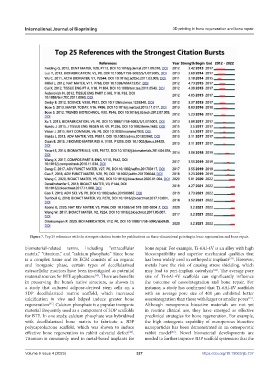Page 335 - IJB-9-4
P. 335
International Journal of Bioprinting 3D printing in bone regeneration and bone repair
Figure 7. Top 25 references with the strongest citation bursts for publications on three-dimensional printing in bone regeneration and bone repair.
biomaterial-related terms, including “extracellular bone repair. For example, Ti-6Al-4V is an alloy with high
matrix,” “titanium,” and “calcium phosphate.” Since bone biocompatibility and superior mechanical qualities that
[43]
is a complex tissue and its ECM consists of an organic has been widely used in orthopedic implants . However,
and inorganic phase, certain types of decellularized metals have the risk of causing stress shielding, which
[44]
extracellular matrices have been investigated as potential may lead to peri-implant osteolysis . The average pore
[40]
material sources for BTE applications . There are benefits size of Ti-6Al-4V scaffolds can significantly influence
in preserving the bone’s native structure, as shown in the outcome of osseointegration and bone repair. For
a study that cultured adipose-derived stem cells on a instance, a study has confirmed that Ti-6Al-4V scaffolds
3DP decellularized matrix scaffold, which increased with an average pore size of 400 μm exhibited better
calcification in vivo and helped induce greater bone osseointegration than those with larger or smaller pores .
[45]
[41]
regeneration . Calcium phosphate is a popular inorganic Although mesoporous bioactive materials are not yet
material frequently used as a component of 3DP scaffolds in routine clinical use, they have emerged as effective
for BTE. In one study, calcium phosphate was hybridized preclinical strategies for bone regeneration. For example,
with decellularized bone matrix to fabricate a 3DP the high osteogenic capability of mesoporous bioactive
polycaprolactone scaffold, which was shown to induce nanoparticles has been demonstrated in an osteoporotic
[46]
effective bone regeneration in rabbit calvarial defect . rabbit model . Novel biomaterial developments are
[42]
Titanium is commonly used in metal-based implants for needed to further improve 3DP scaffold systems so that the
Volume 9 Issue 4 (2023) 327 https://doi.org/10.18063/ijb.737

